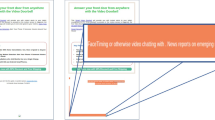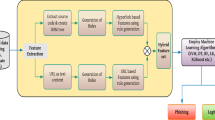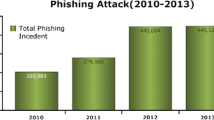Abstract
Currently, the number of Facebook pages is dramatically increased on Facebook because the users can easily create their own pages for free to promote their products and services for marketing purposes. Unfortunately, some of pages are created for malicious intention. Therefore, detecting and identifying malicious Facebook pages is a challenging task. To achieve the task, features extracted from four parts of pages, i.e., page details, product/service details, user responses and post behavior of administrator are examined for the detection. The extracted features are investigated to detect reliable and unreliable pages based on supervised machine learning. First, Facebook pages are randomly collected and then they are labeled by five users. Facebook pages with agreement of five users are selected and their information are retrieved using the Facebook Graph API. Next, features are extracted from the information and investigated in the experiments. The experimental results indicate that the classification prediction is improved to 91.37% of accuracy. Finally, the significant features are analyzed to distinguish between unreliable and reliable pages.


Similar content being viewed by others
References
Statista (2017) Facebook—statistics and facts. https://www.statista.com/topics/751/facebook/. Accessed 22 Dec 2017
Zhu DS, Kuo MJ, Lee TR (2012) Cohesiveness and sense of community of fan club members at facebook pages. In: 2012 13th ACIS international conference on software engineering, artificial intelligence, networking and parallel and distributed computing (SNPD), 8–10 Aug. 2012 2012. pp 362–367. https://doi.org/10.1109/snpd.2012.74
Lin YTJ, Lin MYT, Li KC L (2015) Consumer involvement model of fan page: mining from facebook data of a real celebrity fashion brand. In: 2015 12th international conference on service systems and service management (ICSSSM), 22–24 June 2015 2015. pp 1–6. https://doi.org/10.1109/icsssm.2015.7170187
Peeroo S, Samy M, Jones B (2015) Customer engagement manifestations on Facebook pages of Tesco and Walmart. In: 2015 International conference on computing, communication and security (ICCCS), 4–5 Dec. 2015 2015. pp 1–8. https://doi.org/10.1109/cccs.2015.7374166
Mauda L, Kalman YM (2016) Characterizing quantitative measures of user engagement on organizational facebook pages. In: 2016 49th Hawaii international conference on system sciences (HICSS), 5–8 Jan. 2016 2016. pp 3526–3535. https://doi.org/10.1109/hicss.2016.442
Jeon H, Ahn HJ (2015) Identification of the factors that affect the user reaction to posts on Facebook brand pages. In: 2015 International conference on computer and computational sciences (ICCCS), 27–29 Jan. 2015 2015. pp 203–206. https://doi.org/10.1109/iccacs.2015.7361350
Li-Chun H (2017) Investigating community members purchase intention on Facebook fan page: from a dualistic perspective of trust relationships. Ind Manag Data Syst 117:766–800. https://doi.org/10.1108/IMDS-05-2016-0180
Huang SL, Chen CT (2018) How consumers become loyal fans on Facebook. Comput Hum Behav 82:124–135. https://doi.org/10.1016/j.chb.2018.01.006
Lin KC, Wu SH, Chen LP, Yang PC (2015) Finding the key users in facebook fan pages via a clustering approach. In: 2015 IEEE international conference on information reuse and integration (IRI), 13-15 Aug. 2015 2015. pp 556–561. https://doi.org/10.1109/iri.2015.89
Zhou L, Sung Y-w (2008) Cues to deception in online chinese groups. In: Proceedings of the 41st annual Hawaii international conference on system sciences, 2008. IEEE Computer Society, 1334955, p 146. https://doi.org/10.1109/hicss.2008.109
Zhou L (2005) An empirical investigation of deception behavior in instant messaging. IEEE Trans Prof Commun 48:147–160. https://doi.org/10.1109/tpc.2005.849652
Briscoe EJ, Appling DS, Hayes H (2014) Cues to deception in social media communications. In: 2014 47th Hawaii international conference on system sciences, 6–9 Jan. 2014 2014. pp 1435–1443. https://doi.org/10.1109/hicss.2014.186
Appling DS, Briscoe EJ, Hutto CJ (2015) Discriminative models for predicting deception strategies. In: Proceedings of the 24th international conference on world wide web, Florence, Italy, 2015. ACM, 2742575, pp 947–952. https://doi.org/10.1145/2740908.2742575
Ott M, Choi Y, Cardie C, Hancock JT (2011) Finding deceptive opinion spam by any stretch of the imagination. In: Proceedings of the 49th annual meeting of the association for computational linguistics: human language technologies—volume 1, Portland, Oregon, 2011. Association for Computational Linguistics, 2002512, pp 309–319
Rayana S, Akoglu L (2015) Collective opinion spam detection: bridging review networks and metadata. In: Proceedings of the 21th ACM SIGKDD international conference on knowledge discovery and data mining, Sydney, NSW, Australia, 2015. ACM, 2783370, pp 985–994. https://doi.org/10.1145/2783258.2783370
Ren YF, Ji DH, Yin L, Zhang HB (2015) Finding deceptive opinion spam by correcting the mislabeled instances. Chin J Electron 24:52–57
More S, Kalkundri R (2015) Evaluation of deceptive mails using filtering& WEKA. In: 2015 International conference on innovations in information, embedded and communication systems (ICIIECS), 19–20 March 2015 2015. pp 1–4. https://doi.org/10.1109/iciiecs.2015.7193262
More S, Kulkarni SA (2013) Data mining with machine learning applied for email deception. In: 2013 International conference on optical imaging sensor and security (ICOSS), 2–3 July 2013 2013. pp 1–4. https://doi.org/10.1109/icoiss.2013.6678403
Bhat SY, Abulaish M, Mirza AA (2014) Spammer classification using ensemble methods over structural social network features. In: 2014 IEEE/WIC/ACM International joint conferences on web intelligence (WI) and intelligent agent technologies (IAT), 11–14 Aug. 2014 2014. pp 454–458. https://doi.org/10.1109/wi-iat.2014.133
Zheng X, Zeng Z, Chen Z, Yu Y, Rong C (2015) Detecting spammers on social networks. Neurocomputing 159:27–34. https://doi.org/10.1016/j.neucom.2015.02.047
Gupta A, Kaushal R (2015) Improving spam detection in Online Social Networks. In: 2015 International conference on cognitive computing and information processing (CCIP), 3–4 March 2015 2015. pp 1–6. https://doi.org/10.1109/ccip.2015.7100738
Fire M, Katz G, Elovici Y (2012) Strangers intrusion detection—detecting spammers and fake profiles in social networks based on topology anomalies. doi:citeulike-article-id:13598433
Alowibdi JS, Buy UA, Yu PS, Stenneth L (2014) Detecting deception in online social networks. In: 2014 IEEE/ACM international conference on advances in social networks analysis and mining (ASONAM), 17–20 Aug. 2014 2014. pp 383–390. https://doi.org/10.1109/asonam.2014.6921614
Songram P, Choompol A, Thipsanthia P, Boonjing V (2016) Detecting Thai messages leading to deception on facebook. In: Huynh V-N, Inuiguchi M, Le B, Le BN, Denoeux T (eds) Integrated uncertainty in knowledge modelling and decision making. Springer International Publishing, Cham, 2016// 2016, pp 293–304
The Graph API. (2017). https://developers.facebook.com/docs/graph-api. Accessed 5 Nov 2017
Cortes C, Vapnik V (1995) Support-vector networks. Mach Learn 20:273–297. https://doi.org/10.1023/a:1022627411411
Guo G, Wang H, Bell D, Bi Y, Greer K (2003) KNN model-based approach in classification. In: Meersman R, Tari Z, Schmidt D (eds) On the move to meaningful internet systems 2003: CoopIS, DOA, and ODBASE, vol 2888. Lecture notes in computer science. Springer, Berlin, pp 986–996. https://doi.org/10.1007/978-3-540-39964-3_62
Liao Y, Vemuri VR (2002) Using text categorization techniques for intrusion detection. In: Proceeding of the 11th USENIX security symposium, CA, USA, 2002. pp. 5–9
Ceriani L, Verme P (2012) The origins of the Gini index: extracts from Variabilit e Mutabilit (1912) by Corrado Gini. J Econ Inequal 10:421–443. https://doi.org/10.1007/s10888-011-9188-x
Liu H, Setiono R (1995) Chi2: feature selection and discretization of numeric attributes. In: Proceedings of the seventh international conference on tools with artificial intelligence, 1995. IEEE Computer Society, 832359, p 88
Duda RO, Hart PE, Stork DG (2000) Pattern classification, 2nd edn. Wiley, Hoboken
Fonti V, Belitser E (2017) Feature selection using LASSO. https://beta.vu.nl/nl/Images/werkstuk-fonti_tcm235-836234.pdf. Accessed 30 Mar 2017
Tibshirani R (1996) Regression shrinkage and selection via the Lasso. J R Stat Soc Ser B (Methodological) 58:267–288
Acknowledgements
This research was financially supported by Mahasarakham university research support and development found.
Author information
Authors and Affiliations
Corresponding author
Additional information
This work was presented in part at the 23rd International Symposium on Artificial Life and Robotics, Beppu, Oita, January 18–20, 2018.
About this article
Cite this article
Songram, P. Detection of unreliable and reliable pages on Facebook. Artif Life Robotics 24, 278–284 (2019). https://doi.org/10.1007/s10015-018-0509-z
Received:
Accepted:
Published:
Issue Date:
DOI: https://doi.org/10.1007/s10015-018-0509-z




